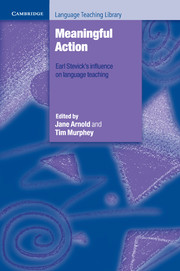Book contents
- Frontmatter
- Contents
- List of contributors
- Acknowledgements
- Preface
- Introduction
- Part A Meaning-making inside and between the people in the classroom
- Part B Meaningful classroom activity
- Part C Frameworks for meaningful language learning
- Epilogue: A way with words – perspectives on the contributions and influence of Earl W. Stevick
- Appendix: Words of tribute to Earl Stevick
- Index
5 - Putting our Trust in the learner
Published online by Cambridge University Press: 15 November 2023
- Frontmatter
- Contents
- List of contributors
- Acknowledgements
- Preface
- Introduction
- Part A Meaning-making inside and between the people in the classroom
- Part B Meaningful classroom activity
- Part C Frameworks for meaningful language learning
- Epilogue: A way with words – perspectives on the contributions and influence of Earl W. Stevick
- Appendix: Words of tribute to Earl Stevick
- Index
Summary
Introduction
In his inspirational book Memory, Meaning and Method (1976), Earl Stevick directed our attention to many matters concerning language learning which have engraved themselves onto the hearts and minds of a whole spectrum of language teachers, and through them, on their learners. His focus on language teaching has always been couched in terms of principle, not just of models of practice, urging dialogue with teachers and especially with learners in whom he placed his Trust as cognitive, human and social beings at the centre of his inquiry.
Stevick's focus on the learner may appear at first map-like, outlining a territory, offering landmarks for the reader/practitioner: on the nature of learner contributions and success; the importance of metacognitive knowledge and learner beliefs; how learners construct themselves, their fellow learners and their teachers; how learners’ worlds and discourses outside the classroom impinge upon their construction of, and participation in, the worlds and discourses within the classroom. One of the key messages in Stevick's work is that meaning is not static; it does not exist a priori (like a map or list of facts), but rather it is interpreted through the lens of students’ experiences, and ‘a world of meaningful action’ is created which differs from one student to another. The depth of meaning that a piece of information has for a student depends on its relevance to the student's previous experiences. As Stevick writes, this word of meaningful action in the classroom
is not a flat, two-dimensional thing like a map. Its structure has many dimensions, and some of its parts are much further from the surface than others. If what a student says makes little or no difference to him, it has little ‘depth’, in this sense. But some things that he says, or hears, or reads, make a difference to him in many ways. This kind of experience is relatively ‘deep’. It draws more energy from his ‘world of meaningful action’, and in turn it helps to shape that world. (1980: 9) In addition to this ‘inside the learner’ focus is his emphasis on the interactional order constructed mutually between teachers and students.
There are many such examples in his writings, such as his reference to factors likely to build Trust or destroy it (Stevick 1976: 95–9). The unifying element of these factors is mutually agreed communication.
- Type
- Chapter
- Information
- Meaningful ActionEarl Stevick's Influence on Language Teaching, pp. 79 - 94Publisher: Cambridge University PressPrint publication year: 2013
- 2
- Cited by



